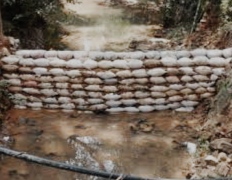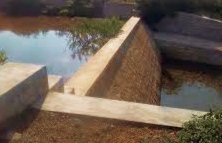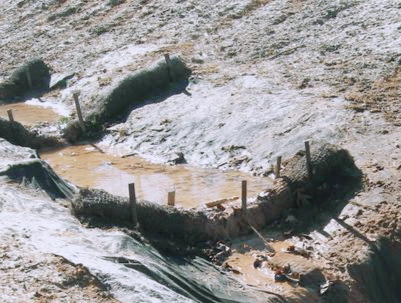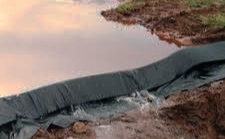In this blog article, we will discuss about check dam. As the name suggest, it is used to control the flow rate of the water.

Let’s start!
Table of Contents
What Is A Check Dam?
Check dam is a linear structure to to control erosion by slowing the flow. It is built perpendicular to concentrated flows across the canal.
Features Of Check Dam
- Control dams hold back flood waters and collect sediment. Best suited for drainage areas of 10 hectares or less.
- Building a dam is relatively cheap and easy.
- Dam materials may include fibrous logs, rocks, sandbags, triangular dams, concrete, steel, prefabricated systems, or other materials.
- A dam consists of a dam and a spillway. Some dams consist of only one dam.
- Straw bales and mud fences are not intended for concentrated flow areas and should not be used for control dam applications.
- At the start of construction, a body of water is created behind the dam. Gradually the water body fills with sediment.
- The area formed by sediments is usually used as agricultural land, as it plays an integral role in grain production in the area.
- Check dams are typically used in areas of concentrated flow, but not in streams or waterways. It can be a permanent or temporary barrier that prevents erosion and promotes subsidence by slowing flow.
Main Functions Of Check Dam
A check dam is built according to the following idea and is pre-designed to do so:
- To slow down the water’s motion.
- By silting up and trapping the silt, you can lower the slopes in a gully and raise the bed level.
- Firmly support the sloping side slopes.
- Encourage soil water percolation and water conservation for plant growth and the strength of banks.
Types Of Check Dam
1. Based on Objective
(a) Temporary Check Dam
These check dams are only built for a short period of time.
Temporary check dams are typically built using rocks, logs, and sandbags.

(b) Permanent Check Dam
These dams are built on an ongoing basis.
These dams are often built out of rock, concrete, steel, or a combination of two or more of these elements.

2. Based On Material
(a) Rock Check Dam

(b) Concrete Check Dam

(c) Rubber Check Dam

(d) Fiber Log Check Dam

(e) Silt Dike Check Dam

(f) Sand Bag Check Dam

Check Dam Design
1. Site Selection Criteria For Check Dam
- The area should be large enough to allow for significant runoff.
- For the spillway to handle the anticipated maximum runoff, it must be big enough and have enough freeboard.
- It ought to be created at a straight, solid streambed. It shouldn’t be constructed near a bend where streams or gullies converge.
- The base rock should support the check dams’ foundation.
- The location selection is also limited by the structure’s height. If there is an excessive elevation difference between the two sides, a side or sides must be chosen in between to limit the structural height.
2. Gradient
Check dams should be spaced apart enough to produce a gradient along the line connecting the top of the lower check dam and the bottom of the subsequent upper check dam.
This gradient will result in a flow velocity that is not erosive. A compensatory gradient is what this gradient is called.
For ordinary practice, the compensation gradient is estimated to be between 3 and 5% of the slope. The horizontal separation between subsequent check dams is calculated as follows:
b=h*100/(So-Se)
where,
h=Height of the check dam up to the notch b=spacing between two check dams
So is % of the existing bed slope.
Se is the % of the new slope.
3. Number
The following formula is used to determine how many check dams are necessary:
Check dam count =(a-b)/H
where,
Between the first and last dam, there is a total vertical distance of a=Se*d’/100.
d’=horizontal separation between the first and last dam
H stands for height.
Benefits of a Check Dam
- It offers a provision for irrigation.
- It slows the flow rate and aids in protecting riverbanks.
- cheaper than other types of dams.
- The check dam’s construction is straightforward. Therefore, there is no need for cutting-edge equipment and technology.
- It aids in preventing flooding and erosion.
- It makes small-scale electricity production easier.
Negative aspects of Check Dam
- The water table below the ground rises as a result.
- aquatic life is affected.
- Its strength and life span are constrained.
- Removal could be expensive, depending on the type of check dam placed.
- upkeep is primarily necessary after heavy rain.
Faqs
Check dams are built by placing big rocks or boulders across rivers or streams. Sometimes, people use concrete or special wire structures called gabions. Engineers carefully plan and build them to stop the water and help with water management.
Check dams can last for a long time, usually between 10 and 50 years. If they are well-made and taken care of, they can even last longer. Regular checks and repairs are important to keep them working well and lasting a long time.
Yes, check dams can be used in cities to manage water during heavy rains and prevent erosion. They can be built in channels or other places where water flows to slow it down and prevent flooding. Using check dams in cities helps control water and keeps urban waterways healthy.
Check dams help groundwater by slowing down water and letting it soak into the ground. When water collects behind a check dam, it seeps into the soil, refilling underground water stores. This raises the water level underground, making more water available for farming, homes, and nature.
Yes, there may be rules and guidelines for building check dams depending on where you live. You need to follow these rules to make sure the dams are built safely and correctly. It’s important to ask experts or government agencies for advice to meet these rules. The guidelines cover things like design, protecting the environment, and making sure the dams are safe.
